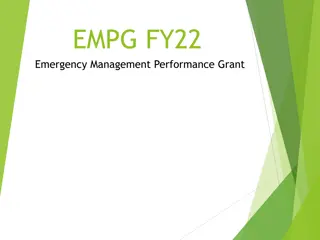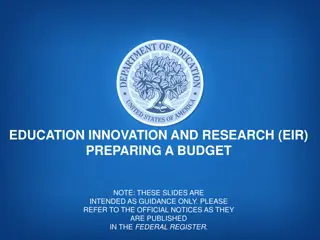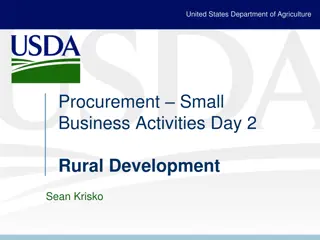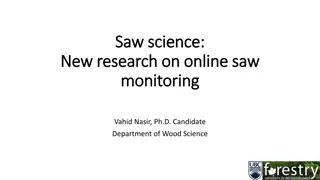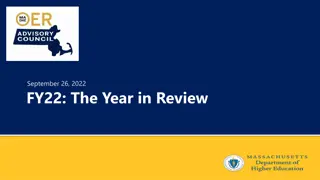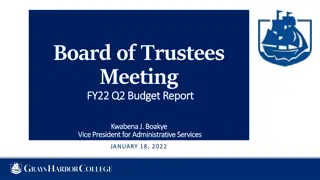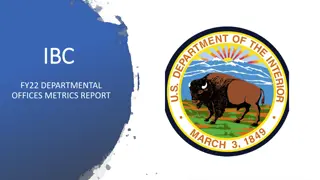Education Innovation and Research (EIR) FY22 Monitoring Overview
The Education Innovation and Research (EIR) program focuses on establishing partnerships with grantees to allow flexibility in decision-making while ensuring excellence, accountability, and successful outcomes. Monitoring is essential for compliance, fraud prevention, and fiscal responsibility. The monitoring protocol helps in reviewing grantee activities, ensuring adherence to program requirements, documentation, and indicators. The process involves selecting grantees systematically for monitoring based on data analysis.
Download Presentation

Please find below an Image/Link to download the presentation.
The content on the website is provided AS IS for your information and personal use only. It may not be sold, licensed, or shared on other websites without obtaining consent from the author.If you encounter any issues during the download, it is possible that the publisher has removed the file from their server.
You are allowed to download the files provided on this website for personal or commercial use, subject to the condition that they are used lawfully. All files are the property of their respective owners.
The content on the website is provided AS IS for your information and personal use only. It may not be sold, licensed, or shared on other websites without obtaining consent from the author.
E N D
Presentation Transcript
EDUCATION INNOVATION AND RESEARCH (EIR) FY22 MONITORING
PURPOSE OF PURPOSE OF MONITORING MONITORING The goal of monitoring is to establish partnerships with grantees that allow for flexibility in local decision-making, in conjunction with a results-oriented approach to program management that demonstrates excellence, accountability, and successful performance outcomes. Monitoring addresses ED s fiduciary responsibility to ensure the grantee s legal and fiscal compliance and to protect against fraud, waste, and abuse.
THE MONITORING PROTOCOL THE MONITORING PROTOCOL This document will assist EIR program officers and their assigned grantees in preparing for various monitoring activities by outlining the scope of the review process and identifying the materials and documentation needed for review and analysis by ED. This guide describes in detail the purpose, rationale, and process used by the EIR program in monitoring the use of discretionary grant funds distributed by ED.
MONITORING INSTRUMENT MONITORING INSTRUMENT Monitoring grantees implementation of EIR means analyzing how grantees have instituted their project designs as described in their approved applications to ensure compliance with applicable statutes and regulations. These requirements and principles are embedded in the EIR Monitoring Instrument. ED staff will use the grantee s response to the monitoring instrument to understand how the grantee has met EIR and federal requirements.
MONITORING INSTRUMENT MONITORING INSTRUMENT 3 columns: Program Requirements, Acceptable Documentation, and Indicators. Program Requirements includes applicable statutory or regulatory requirements for EIR. Acceptable Documentation specifies a list of specific documentation that grantees should submit to help demonstrate adherence to these requirements. Grantees do not need to submit multiple copies of the same document. If a document is listed in more than one section of the monitoring instrument, the grantee can make a reference to where ED staff can find the document within the information submitted. Indicators provides a general guide on what ED staff are trying to determine. Grantees can use the indicators in the last column to understand the standards ED staff will use while monitoring.
THE MONITORING PROCESS THE MONITORING PROCESS SELECTING GRANTEES FOR MONITORING The EIR program uses a systematic approach to identify and select grantees to monitor. Each year, ED program staff complete an analysis of each EIR grant to determine the need for monitoring that is based on information from several different data systems and sources. This analysis considers various domains including progress towards program goals and objectives, fiscal management, annual reporting, information from quarterly and ongoing monitoring calls, past monitoring, audit reports, risk assessments, and other critical areas related to implementation of EIR program requirements.
Target group: 60 grantees FY18-19 Risk Analysis Summary The risk analysis reflects the data collection, analysis, and staff discussion that informs which sites are considered for monitoring Entity Risk Review G5 Data Programmatic Data Entity Risk Review Categories Administrative Financial Internal Controls
Entity Risk Review Categories FINANCIAL ADMINISTRATIVE INTERNAL CONTROLS Shows how the applicant conducts its finances, not only with the department, but with the wider business world Represents a grantee s previous history of compliance with department and program requirements Based on an entity s A-133 audit findings for the previous 5 years
G5 Data Reports from g5 are used to review the following: Excessive drawdowns Large available balance
Programmatic Data Key considerations for suggested ranking of monitoring priority include: number of open EIR grants, award size/tier, GPRA data, entity type, and program officer input. Rank order will dictate, based on IELP travel funds, how many are on-site versus virtual. Grantees outside of rank order can be prioritized for enhanced program officer contact (more regular calls, email updates in between quarterly calls, etc.)
MONITORING SCHEDULE After EIR staff complete the analysis of each EIR grant, they identify grantees that will receive a virtual or on-site review and determine if a targeted or comprehensive review is needed. Additional monitoring may be arranged, as needed, if a grantee has serious or chronic compliance problems or has unresolved issues identified during the monitoring process. Once ED staff have identified the grantees that will receive a monitoring review the program officer will work with their assigned grantees to select dates for the review. The program officer will send a Grantee Monitoring Review Notification Email to the project director before the review date.
MONITORING REVIEW TEAM The monitoring review team includes the assigned program officer and other EIR team members, who assists assigned program officer during the review. However, other OESE or ED staff are not precluded from participating depending on the needs identified by the assigned program officer.
TYPES OF MONITORING TYPES OF MONITORING The EIR program monitoring plan consists of four types of monitoring that helps grantees build capacity through technical assistance and that helps ensure program compliance: 1. Targeted Virtual Review 2. Comprehensive Virtual Review 3. Targeted On-site Review 4. Comprehensive On-site Review
Virtual Monitoring Reviews Virtual Monitoring Reviews Targeted virtual reviews are used as a form of monitoring when program officers have identified specific area(s) of potential concern or interest but have determined that a comprehensive virtual review of the grant project is not necessary. As such, targeted virtual reviews will not include the entire EIR Monitoring Instrument and program officers will notify the grantee which specific sections to use prior to the review. Targeted virtual reviews typically take one day to complete and will include a review of documentation and interviews with key personnel or staff who have direct oversight of the area in question. A comprehensive virtual review takes approximately 1 to 2 days; however, depending on the needs identified by the program officer, the number of days may change. This type of review includes all of the Program Requirements in the EIR Monitoring Instrument.
On On- -site Monitoring Reviews site Monitoring Reviews Targeted on-site reviews are used when program officers have identified specific area(s) of potential concern or interest and a comprehensive review of the grant project is not necessary. Prior to the review, the program officer will notify the grantee which Program Requirements from the monitoring instrument will be monitored. Targeted on-site reviews will typically take 1 to 2 days to complete and will include a review of documentation and interviews with key personnel or staff who have direct oversight of the area in question. Comprehensive on-site review follows the same process as the comprehensive virtual review but is done in person. On-Site reviews take approximately two days; however, depending on the needs identified by the program officer, the number of days may change. This type of review includes all of the Program Requirements in the EIR Monitoring Instrument.
Monitoring Review Activities Monitoring Review Activities Pre-review activities include: (a), Notification and scheduling, (b) solidifying the agenda, and (c) providing to the program officer responses to the monitoring instrument. Review activities - The actual monitoring review will take approximately 1 to 2 days and, depending on the type of review, may include: (a) review of documentation, (b) interviews with key personnel and staff, (c) roundtable discussions with educators, students, and parents and (d) exit conference. Post-review activities include an: (a) monitoring report, (b) response to required corrective actions (if required), (c) technical assistance, if needed, and (d) conditions (if necessary).
The monitoring review process is a collaborative effort of all stakeholders involved with the implementation of the grant.



